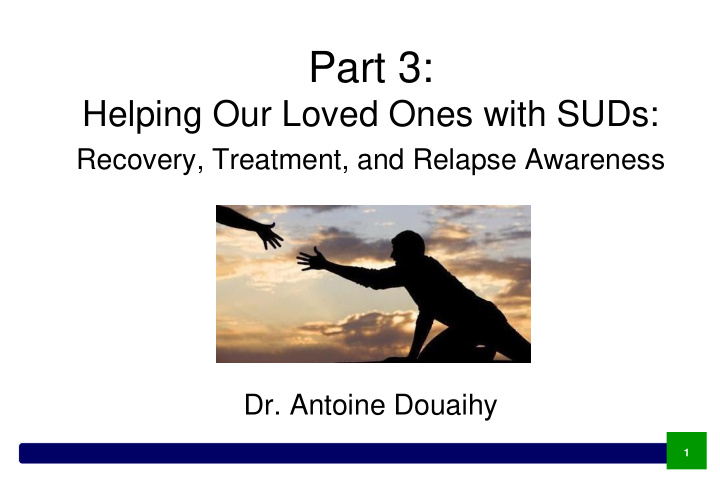



Part 3: Helping Our Loved Ones with SUDs: Recovery, Treatment, and Relapse Awareness Dr. Antoine Douaihy 1 1
SAMHSA Working Definition of Recovery (Revised 2012) “ Recovery from substance use disorders is a process of change through which individuals improve their health & wellness, live a self-directed life, and strive to reach their full potential” 2 2
Recovery Domains Physical and Lifestyle Psychological/Emotional Family Social and Interpersonal Spiritual Financial 3 3
Ways to Recover Solo Treatment Assisted (+/- medications) Peer Assisted Recovery Family Recovery Other 4 4
Influencing Our Loved One Communication Problem Solving Conflict Resolution Many ways to be helpful 5 5
Best Practices for Treatment Evidence Based Practices Integrated Treatments (addiction, psychiatric, medical, social) Combined Approaches (medication, therapy, mutual support) 6 6
Best Practices for Treatment Therapy Mutual Support Family Involvement Medication Assisted Treatment 7 7
Medication Assisted Treatment Functions : – Detoxification – Maintenance: reduce cravings and relapse risk – Stabilize function, promote engagement Alcohol : – Naltrexone (ReVia; injectable Vivitrol), Campral Opioids : – Naltrexone, Methadone, Buprenorphine 8 – Naloxone: reverses opioid overdoses, saves lives!!! 8
Relapse: Definitions A recurrence of symptoms of a disease after a period of improvement (Webster) A breakdown or setback in an attempt to change or modify a target behavior (Marlatt) An unfolding process in which substance use is the last event in a long series of maladaptive responses to internal or external stressors or stimuli (NIDA) 9 9
How to Think about Relapse Common with medical, psych, SUD, and life Can’t always be prevented Learning and using recovery skills takes time Early recovery is most vulnerable time for relapse (90 days; 180 days; year 1) Not all clients want recovery! -Daley & Marlatt, 2006; Hunt, 1971; Marlatt & Donovan, 2005 10 10
Causes and Effects of Lapse or Relapse Many factors contribute to lapse or relapse – Can occur suddenly or gradually – Severity and effects of relapse will vary Ignoring relapse warning signs Not using skills to manage hi-risk situations Family, social support, lifestyle issues Nature of addiction Poor adherence to treatment 11 11
Effects of Relapse Vary from therapeutic to fatal Effects depend on multiple factors (severity, coping skills, support, etc) Relapse affects: – Client – Family: worry, upset, angry, etc – Provider – Society 12 12
Strategies to Reduce Relapse Risk Identify/manage high-risk situations Identify/manage early warning signs Manage negative emotions Resist social pressures to use substances Build a recovery network Work towards wellness/balanced lifestyle Know how to stop a lapse or relapse 13 13
Recovery Relapse 14 Road to Recovery or Relapse? 14
15 15
Recommend
More recommend